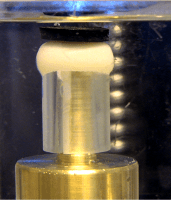Fractographic analyses of all-ceramic crowns that have failed during clinical use show different fracture features compared with those commonly observed in laboratory studies. Until now, in vitro tests which have been published usually show contact damage induced at the loading point – occlusally for molars and premolars and lingually for incisors. Clinically failed crowns, on the other hand, seem to fracture from cracks initiated in the cervical margin in the core material, usually in the approximal region.
The aim of this project was to develop a method for simulating clinical fracture in vitro. The primary goal was to mimic application of forces that produce fractures starting in the cervical margin, as observed clinically. Different methods were tested and all fractures were compared with a reference group of clinically failed crowns. The most clinically similar fractures were created by using an abutment material with a Poisson’s ratio similar to dentine and by cushioning the occlusal load in order to avoid contact damages. In all the crowns tested, the fracture started cervically and in the approximal area, as observed clinically.
The preliminary conclusion is that clinically relevant fracture testing of all-ceramic crowns should induce lateral forces in the cervical margin and avoid contact damages at the loading point. Further studies are necessary to establish the applicability of the method for all dental ceramic materials and for different types of crown shapes.
The method may be a way to compare different ceramic materials and also to assess design parameters to lower the fracture risk of all-ceramic crowns.


Figure 1. Specimen with cushion of rubber in water at 37 °C with a split mold before testing.
Figure 2. One cracked specimen on an epoxy mold.
From
Øilo M, Kvam K, Tibballs JE, Gjerdet NR.
Clinically relevant fracture testing of all-ceramic crowns.
Dental Materials. August 2013 (Vol. 29 | No. 8 | pp. 815–823).
Download
NOIM Newsletter August 2013
